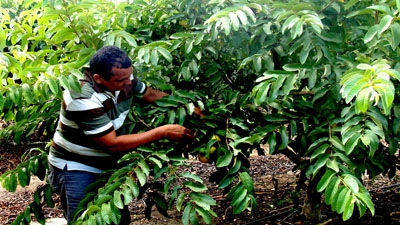Forquilha Valley, Quixeramobim, Ceará – here, in the heart of one of Brazil’s driest states, green, healthy fruit crops contrast with the nearby desolate landscapes.
While papaya flowers blossom, nearly ripe guavas hang from the trees, spreading a light scent. “Get some, there’s plenty,” says 47-year-old Deusimar Cândido, manager of the local small farmers association, as he picks up the best ones.
Around a decade ago, such abundance was something he – and the 180 families that live in the region – could hardly imagine. “We planted corn and beans, and relied solely on rainfall for agriculture,” he recalls.
With the support of a three-phased partnership between the World Bank and the government of Ceará, they got the technology that enables them to pull water from the soil year-round.
They also installed a drip irrigation system – which uses hoses and nozzles to distill water only where plants need it. “We can plant fruit and vegetables without pesticides, and sell them to local markets. Each family makes at least BRL 1,500 a month,” he adds.
Now Cândido dreams of the day when he and other farmers will have access to more modern, computer-controlled sprinklers.
“Drip irrigation works well for semi-arid lands because it allows farmers to diversify crops and enhance yields while minimizing water consumption,” says Fatima Amazonas, a rural development specialist at the World Bank.
From 2001, when the project started its first phase (the second one began five years later), to 2010 approximately 185,500 families all over the northeastern state reaped similar benefits.

